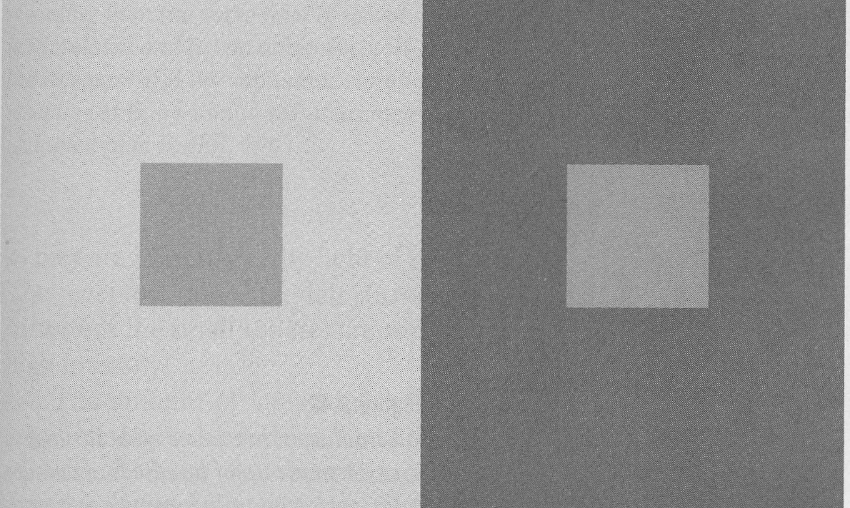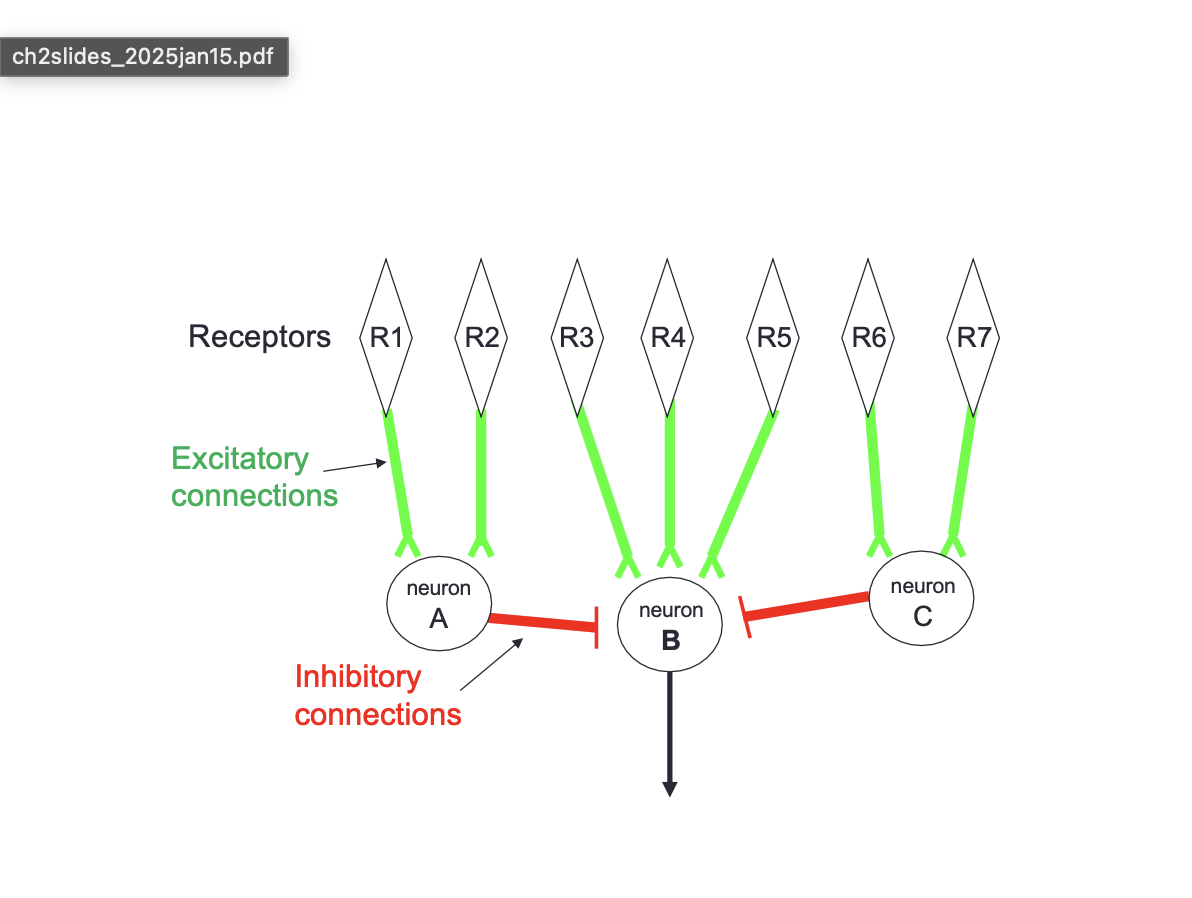PS262 Ch 1, appendices, 2 and 3
1/91
There's no tags or description
Looks like no tags are added yet.
Name | Mastery | Learn | Test | Matching | Spaced |
|---|
No study sessions yet.
92 Terms
Three main methods of study for Perception
physiological (hardware analysis)
cognitive (software level of analysis)
psychophysical (connects objective measurements to reports of subjective experience)
Neurons
units of processing
relationship between nerve impulses and specific perceptions
How do neurons communicate with each other?
pre-snyaptic neuron communicates with the post synaptic neuron by sending neurotransmitters
Spontaneous activity
resting rate or base rate without stimulation, meaning the neuron fires even without action potential
refractory period
the time following an action potential when a neuron is unable to fire another action potential due to temporary inactivation of sodium channels.
Single-cell recording technique
A method used to measure the electrical activity of a single neuron, typically by inserting a microelectrode into the cell.
Magnetic Resonance Imaging (MRI)
focuses on detailed images of brain structure
Functional Magnetic Resonance Imaging (fMRI)
measures changes in blood flow, blood flow increasesin areas of the brain that are more active, providing insights into brain function.
Electro-Encephalograhpy (EEG)
Measures electrical activity through scalp/skull
using electrodes placed on the scalp, allowing for the assessment of brain wave patterns and activity.
Bottom-up processing
perception begins with raw sensory input from environment
starts at sensory receptors such as eyes and ears, moves upwards to brain and culminates in perception and interpretation of stimuli.
you see a new object, an unfamiliar tool, and try to figure out its purpose by analyzing its shape and features
Top-down processing
perception is influenced by prior knowledge, experiences and expectations
you see a blurry picture of dog and recognize it quickly because you except it to be a dog based off its features
Do we perceive reality directly?
No, our perception is influenced by cognitive processes, prior knowledge, and sensory input.
Psychophysics
determining the quantitive relationships between
physical stimulus (external)
perception (internal psychological)
Absolute threshold
smallest amount of stimulus energy necessary for the observer to detect a stimulus
Difference threshold
or just noticeable difference
smallest difference between two stimuli person can detect
minimum change needed to tell a difference between two
standard stim - 200 g
second standard stim - 200 g + 10 g
you can tell second is heavier, thus 10 g is the noticeable difference
Response criterion
amount of sensory information an observer requires to say yes
low criterion
says yes even if they don’t perceive much evidence for tone
liberal responder
high criterion
less willing to say yes
conservative responder
Catch trials
no target
used to assess response bias by including trials without the target stimulus.
Receiver Operating Characteristic curves
shows sensitivity and decision bias are separate factors
a persons sensitivity (ability ti distinguish signals from noise) is represented by the shape of the curve
bias affects on the placement of the curve along the x-axis.
Good sensitivity
curve would bend closer to top left, indicating higher ability to correctly identify targets with fewer false alarms.
poor sensitivity
curve bends closer to bottom right, meaning more false alarms and a lower ability to correctly identify targets.
magnitude estimation
relationship between intensity of a stimulus and the perception of its intensity
Perceptual process
stimulus in environment, distal stimulus
stimulus hits receptors, proximal stimulus
receptor processes
neural processing
perception
recognition
action
Stimulus in environment (distal stimulus)
object in external world, such as a tree
stimulus hits receptors (Proximal stimulus)
light from distal stimulus reaches eye and creates a proximal stimulus on retina
Receptor proceses
receptors in eye, rods and cones in retina, convert light energy into electrical signals
process called transduction
neural processing
electrical signals generated by receptors are transmitted through networks of neurons in brain
processes fine information and contributes to perception
perception
brain interprets neural signals to generate perception of object, such as recognizing characteristics like colour or shape of tree
recognition
perceived object is compared with stored knowledge in brain, allowing for recognition
action
individual takes action on perception and recognition and walks over to tree
Method of limits
presenting stimuli in ascending or descending order to determine at which point a person can or cannot detect a stimulus
Method of constant stimuli
different stimulus intensities are presented one at a time, participant must rescind whether they perceive it or not on each trial
presented at random
Method of adjustment
participants, rather than experimenter, adjust stimuli to a point where they can no longer detect it
Electromagnetic spectrum
The range of all types of electromagnetic radiation, including visible light, radio waves, and X-rays, categorized by wavelength.
cerebral cortex
The outer layer of the brain, responsible for complex cognitive functions, including perception, reasoning, and decision-making.
oblique effect
The phenomenon where sensitivity to contrast varies with orientation, often showing enhanced perception for vertically and horizontally oriented stimuli compared to obliquely oriented ones.
Phenomenological report
A qualitative research method that captures participants' lived experiences and perceptions regarding a specific phenomenon.
Inhibition
A process that decreases the likelihood of a neuron firing an action potential, often regulating neural activity and maintaining balance within neural circuits.
lateral inhibiton
the capacity of an excited neuron to reduce the activity of its neighbours
Low level neural circuitry
Refers to the basic neural networks and connections that process sensory information and regulate simple reflexive responses.
simultaneous contrast
A perceptual phenomenon where the color or brightness of one area is affected by the adjacent area, making it appear different than it actually is.

Convergence
more than one neuron providing input for a neuron

Neuronal connectivity and lateral inhibition
receptors 1-7 are sensory receptors that detect stimuli
neurons a,b and c, recieven inout from receptors through excitatory connections
neuron b is the central neuron
neurons A and C send inhibitory signals to neuron B which decreases activity of the neuron B
Receptive field (RF)
region of retina that, when stimulated, influences firing rate of a particular neuron.
could make neuron fire more, excitatory
could make neuron fire less, inhibitory
Center-surround receptive fields
A type of receptive field organization where the center response is opposite to the surround response, enhancing contrast in visual stimuli.
Specificity Coding
The theory that individual neurons respond to specific stimuli, encoding particular features of the visual environment.
grandmother cell
Sparse coding
A neural coding strategy where only a small number of neurons are active to represent a stimulus, allowing for efficient information processing.
Population Coding
A coding method where a large group of neurons collectively represents a stimulus, allowing for a more robust and flexible encoding of information.
Cell body
contain mechanisms to keep cell alive
Dendrites
branch out from cell body to receive electrical signals
axon
filled with fluid that conducts electrical signals
Sensory receptors
neurons specialized to respond to environmental stimuli
Action potential
the electrical impulse that travels down the axon, triggering neurotransmitter release, positive charge on the inside and negative charge on the outside of the membrane, resulting in a rapid depolarization followed by repolarization.
Resting potential
the state of a neuron when it is not firing, characterized by a negative charge inside the cell compared to the outside.
depolarization
the process of reducing the membrane potential, making the inside of the neuron less negative compared to the outside.
hyperpolarization
the process of increasing the membrane potential, making the inside of the neuron more negative compared to the outside, often following an action potential.
Excitatory response
a change in membrane potential that makes a neuron more likely to fire an action potential, often due to the influx of sodium ions.
Inhibitory response
a change in membrane potential that makes a neuron less likely to fire an action potential, often due to the influx of chloride ions or the efflux of potassium ions.
Sensory Coding
process by which sensory stimuli translates environmental stimuli into neural signals that brain can interpret
is there a salty neuron in your brain that only fires in response to salt so you perceive saltiness?
or, multiple neurons fire in one or multiple brain areas, that result in our perception of salt ?
Phrenology
the study of the shape and size of the skull as a supposed indication of character and mental abilities.
Modularity
specific brain areas are specialized to respond to specific types of stimuli or functions
Broca’s area
Involved in speech production, frontal lobe
Wernicke’s area
Involved in speech comprehension, temporal lobe
Distributed Representation
brain represents information all across the different regions of brain, instead of just one specific area. This allows for a more complex and nuanced processing of information.
when your brain responds to pain
sensory, emotional and reflexive motor all work together to help you perceive pain
Structural Connectivity
the physical connections between brain regions, including axons and synapses, that enable communication and information flow throughout the brain.
the highways
Functional Connectivity
neural activity associated with a particular function that is flowing through the structural networj
the shops the highways are connected to
Mind-Body Problem
The philosophical debate concerning the relationship between mental processes and physical states of the brain,
how do physical processes, like nerve impulses, transform into perceptual experiences ?
Accommodation
Lens changes shape so that images of nearby objects are not blurry
When lens is flat
focusing on things far away
When lens is fatter
focusing on things near
What helps lens get flat and fat
ciliary muscles
Transduction
transformation of one energy to another
Fovea
the central region of the retina responsible for sharp central vision, containing a high density of Cones
Peripheral Retina
the sides of the retina that are responsible for motion detection and peripheral vision, containing both rods and cones
helps in dark adaptation
Macular Degeneration
common in older people
destroys cone rich fovea and a small area surrounding it
blind region at focal point (so directly ahead)
Retina pigemntosa
degeneration of retina
first attacks peripheral rod receptors and results in poor vision in peripheral fields
Cornea
Transparent covering of the front of the eye
80 percent of focusing power
Lens
remaining 20 percent of eyes focusing power
changes shape to adjust eyes focusing power
Refractive errors
common vision problems caused by the eye's inability to focus light correctly, leading to blurred vision. These include myopia, hyperopia, and astigmatism.
Presbyopia
as people get older, their ability to accommodate decreases, due to hardening of lens and wearing of ciliary muscles
Myopia
inability to see distant objects clearly
can be caused by refractive myopia when cornea or lens bends light too much or axial myopia when eyeball is too long
isomerization
light causes retinal to change its shape from bent to straight
opsin
large protein
retinal
light sensitive molecule
Which photo receptor is important for dark adaptation
rods
Rod pigments regenerate
20-30 mins
Cone pigments regenerate
3-5 mins
What is neural convergence
refers to multiple rods or cones sending signals to a single ganglion cell
rods have what type of convergence?
high (120 rods sends signals to one cell)
cones have what type of convergence
low, 6 cones sends signals to one ganglion cell
sensitivity vs acuity
Rods: high sensitivity to faint light, poor at seeing details (low acuity)
Cones: low sensitivity to faint light, but excellent for seeing details and colours (high acuity)